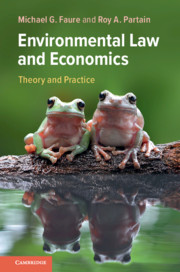Book contents
- Environmental Law and Economics
- Environmental Law and Economics
- Copyright page
- Contents
- Preface
- Acknowledgements
- Abbreviations
- 1 Introduction
- 2 Environmental Harm and Efficiency
- 3 Property Rights Approach to Environmental Law
- 4 Environmental Standard Setting
- 5 Principles of Environmental Law and Environmental Economics
- 6 Pricing Environmental Harm
- 7 Market-Based Instruments
- 8 Liability Rules
- 9 Environmental Regulation
- 10 Environmental Crime
- 11 Insurance for Environmental Damage
- 12 Compensation for Environmental Damage
- 13 Environmental Federalism
- 14 The Role of Environmental Law in Developing Countries
- 15 Epilogue
- References
- Index
3 - Property Rights Approach to Environmental Law
Published online by Cambridge University Press: 13 September 2019
- Environmental Law and Economics
- Environmental Law and Economics
- Copyright page
- Contents
- Preface
- Acknowledgements
- Abbreviations
- 1 Introduction
- 2 Environmental Harm and Efficiency
- 3 Property Rights Approach to Environmental Law
- 4 Environmental Standard Setting
- 5 Principles of Environmental Law and Environmental Economics
- 6 Pricing Environmental Harm
- 7 Market-Based Instruments
- 8 Liability Rules
- 9 Environmental Regulation
- 10 Environmental Crime
- 11 Insurance for Environmental Damage
- 12 Compensation for Environmental Damage
- 13 Environmental Federalism
- 14 The Role of Environmental Law in Developing Countries
- 15 Epilogue
- References
- Index
Summary
This chapter explored the idea of leveraging property rights to enable either better decision making by stakeholders, usually by changing the ex ante information and incentives, or by re-allocating rights as originally suggested by Coase. We explored Hardin’s (in)famous ‘Tragedy of the Commons,’ from the economic perspectives of rivalry (aka subtractability) and excludability. We explored the impacts of observing the three states of rivalrous, non-rivalrous, and anti-rivalrous against both excludable and non-excludable, yielding six types of goods or services. Traditional property concepts, such as rules of first capture or first mover, could lead to inefficient use of resources. Demsetz's theory is that property rights could emerge, sua sponte, internalising externalities that follow from open access; that property rights enable communities to re-balance the impacts of Pigou’s externalities. Demsetz’s theory does not necessarily imply the establishment of private property rights. Again, the issues of rivalry and excludability came into view. Cooter and Ulen advocated that if property rights could be granted for various natural resources, including wildlife, it would benefit the efforts to protect and conserve those resources.
Keywords
- Type
- Chapter
- Information
- Environmental Law and EconomicsTheory and Practice, pp. 37 - 62Publisher: Cambridge University PressPrint publication year: 2019



